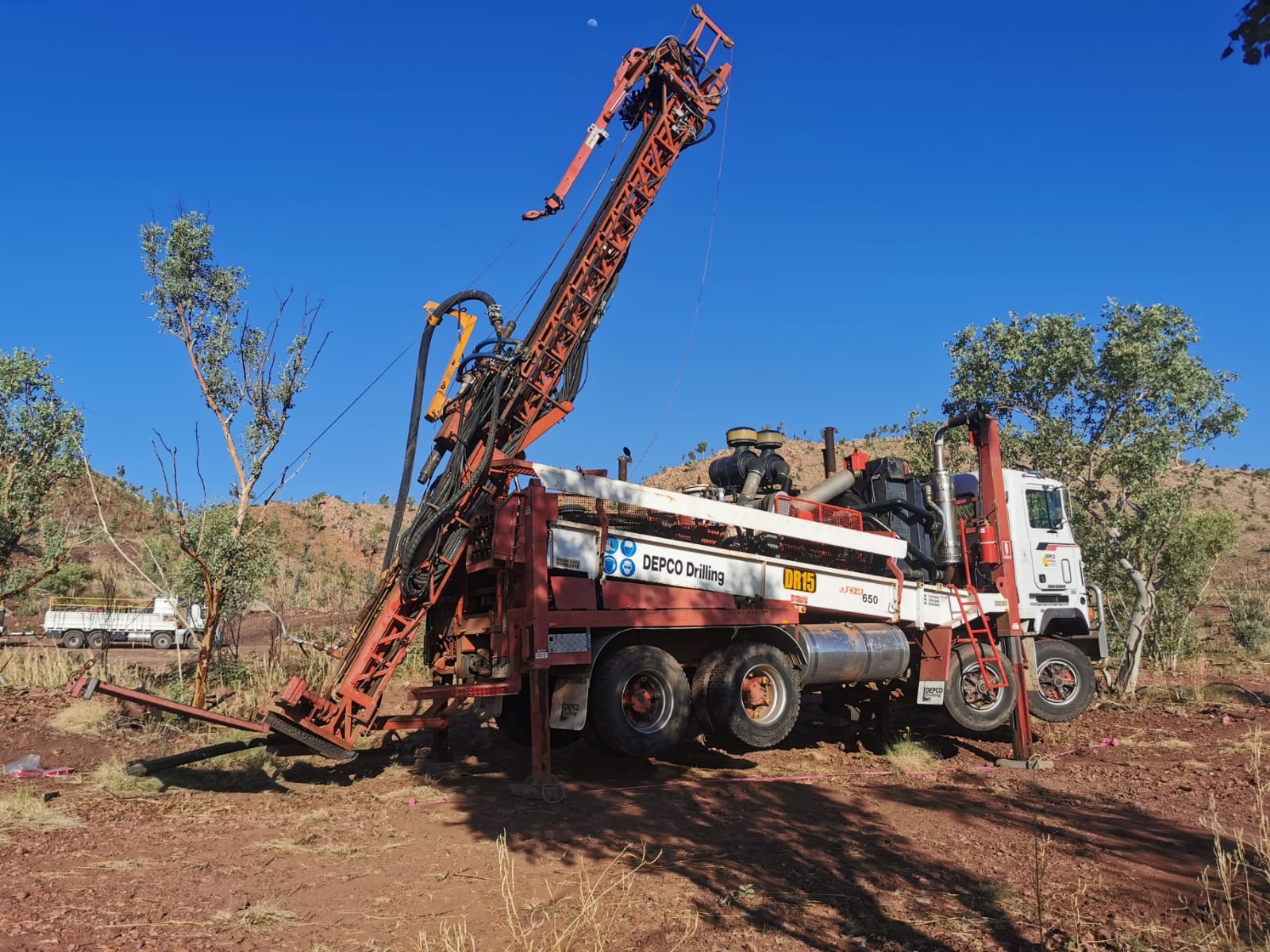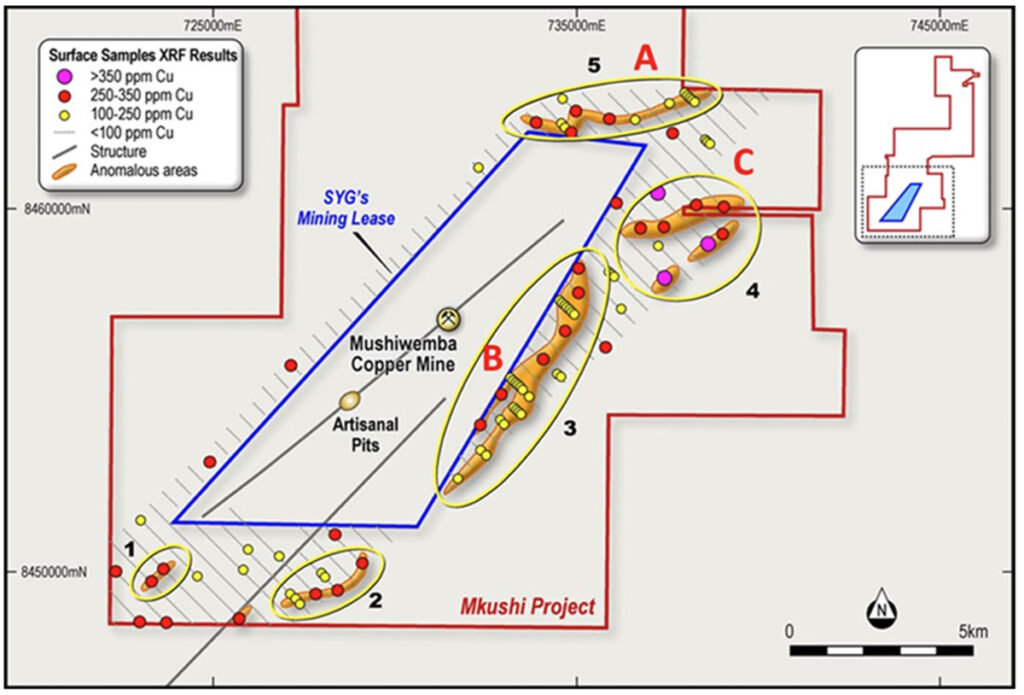LOCATION
Central Province, Zambia
YEAR
Since February 2020
POTENTIAL
8 Prospective Targets
MINERALISATION
Copper, Gold, Manganese
OVERVIEW

Centred on Zambia’s copper-belt, the second largest copper producer in Africa.
The project is situated near well-established mining and ancillary services industry with good infrastructure.
Prospect for continuous mineralisation into Mkushi Project Area from nearby operating copper mine, possibly up to 30Mt at 1.2% Cu.
Situated within the highly prospective Mwembeshi Shear Zone, which has extensive historic exploration and mining activity.
Location
The Mkushi Project is located with the Central Province of north-central Zambia. Access to Mkushi from Lusanka (260km) is by the paved Great Northern Road, which traverses the towns of Kabwe and Kapiri Mposhi before reaching the project’s northern region. The TAZARA railway line to Dar es Salaam cuts through the project’s northern section.
The Mkushi project surrounds the licence held by Shi Yang Group (SYG), which houses a high-grade copper deposit. The SYG mining operation is hosted along the northern trend of two NE-SW shear zone featured 2-3km apart.
The country’s largest copper refinery is Nkana located in Kitwe, 200km from Mkushi.
GEOLOGY
The Mkushi Project is situated within the Mwembeshi Shear Zone (MSZ), which extends from Mumbwa to near Lundazi. This zone, a major geological fault formed during the Pan African Orogeny, has facilitated the surfacing of copper, gold and manganese ores along its path.
The MSZ’s north-easterly trend aligns with many deposits in the Central Province. In the Mkushi region, gold occurrences are linked to granite formations and exhibit gold-bismuth associations. Manganese deposits are predominantly found within the Mkushi-Serenje Belt.
Copper mineralisation at Mkushi is hosted within sub-parallel granitic intrusions and schists, primarily located in the major Mtuga Shear Zone, which cuts through the basement rocks. These basement rocks consist of schists, amphibolite, quartzite, and numerous quartz veins. The dominant copper minerals include chrysocolla, malachite, chalcopyrite, and pyrite. These deposits are found within a broadly northeast-trending structural corridor that mimics the strike of the manganese belts.
Mkushi is characterised by the presence of banded, granulitic, and porphyroblastic gneisses, quartzo-feldspathic schist, quartzites, and metavolcanics, collectively forming the Basement Complex known as the Mkushi Gneiss Formation. This formation is distinguished by pink or grey, coarse-grained migmatitic and granitoid gneisses of largely unknown protolith. The gneisses exhibit various textural attributes, ranging from fine-grained banded gneisses to coarse porphyroblastic granite gneisses covering extensive areas.
The Mkushi Formation is intruded by gabbroic, doleritic, and amphibolitic rocks, as well as aplites, pegmatites, and quartz veins. These intrusions host valuable minerals, including gold, copper, manganese, and various gemstones.
Exploration
The region around Kabwe has a rich history of exploration and mining activity.
Three manganese mines operated around Kabwe until the mid-1960s, contributing significantly to the local mining industry during their operational period.
There are 260 recorded gold occurrences around Kabwe.
Seven discrete copper deposits have been identified along the northeast-southwest trending Mtuga Line, which has a strike length of 14.5 km. This line bisects the SYG Copper Mining Lease.
More recent developments saw the open-pit mine at Mkushi re-opened in mid-2018 after nearly 40 years of inactivity. It has an estimated life of mine (LOM) exceeding 15 years.
In 2008, the previous owner, African Eagle, confirmed a JORC Indicated resource of 18.5 million tonnes (Mt) at 0.83% copper (Cu), demonstrating excellent metallurgy with a 96% metal recovery rate, achieving over 30% copper concentrate.
The prospect for contiguous mineralisation into the Mkushi Project is significant. African Eagle, which owned 467 km² across the same ground, noted that the region could contain 30 Mt at 1.2% copper.
2020 desktop studies discovery a new, undrilled shear zone in SYG’s mining lease, parallel to the existing Mtugu Zone and stretching ~4km into Mkushi Project.
In early 2022, CCZ conducted an IP survey designed to test soil geochemical anomalies for potential disseminated copper mineralisation (Areas A, B & C on map)
- 40 lines across 54km surveyed using a 50m-spaced dipole-dipole electrode configuration
- 20 lines identified for follow-up drilling
In 2020 and 2021 CCZ conducts 2 geochemical surveys, with the study area focused on 4km shear zone and boundary of SYG mining lease.
- Samples collected at 100m intervals along 250m or 500m spaced NW-SE lines
- A total of 1,787 samples collected and pXRF analysed
- 5 geochemical anomalies identified, with strike length ranging from 2-7km (20.5km in total).
In 2023, CCZ developed drill plans to target geochemical, geophysical and magnetic anomalies:
- 15 RC drill holes planned
- Total 3,000m
- Targets Areas A, B & C
It is recommended that exploration activities (e.g. geochemical sampling and geophysical studies) focus on the NE and SW strike extensions of the shear structure associated with the Mtuga Line into the Mkushi Project.
SRK Consultants noted that there is potential that the deposits exposed at surface with the SYG Mining Lease continue undercover into the project area
Extensive heritage data exists comprising geological, geochemical, geophysical (including magnetics / airborne EM) that can be leveraged to validate priority drill targets to delineate resources.



